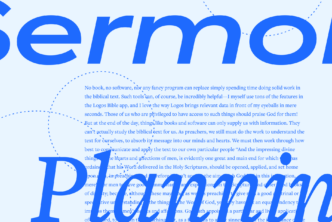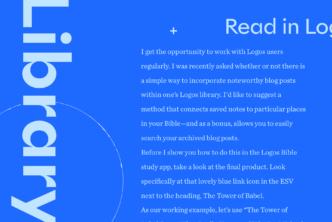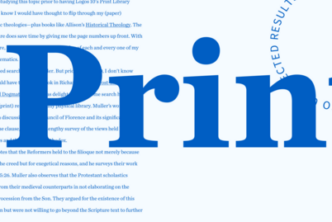It’s the question that can derail the Sunday School class, make the pastor look poorly educated (i.e., “dumb”), and possibly even damage someone’s faith: Pastor, how come this footnote says that some manuscripts do not include the story of the woman caught in adultery?
Pastors need to know something about textual criticism.
But pastors are not generally called to dig deeply into the topic; it’s information overload. This is why I personally use the SBLGNT. I think it ought to be the main Greek text for pastors, because it can help pastors have the kinds of informed opinions they need when they get questions. The SBLGNT is a special critical edition whose apparatus carefully boils down all the complicated textual evidence to a simple, useful summary.
Basically—and as with all textual criticism it’s a mite more complicated than this—it polls the four New Testament texts of 1) Tregelles, 2) Westcott-Hort, 3) Robinson-Pierpont, and 4) Nestle-Aland* and lets you know at any given variant which editions have what. And it does so in an elegantly simple way.
The SBLGNT is not brand new; it’s been out for several years. And in that time I’ve had a chance to put it through its paces. You should use the SBLGNT, too, if you don’t already.
Here are three reasons why.
1. The SBLGNT hits a sweet spot for pastors and other non-specialists
It’s important that pastors maintain the ability to follow the kinds of textual-critical arguments commentaries bring up. But I can’t really say that very many of them should be “doing textual critical work.”
Textual criticism is one of the most complicated and demanding domains of biblical studies. I can and do use the apparatus in the Nestle-Aland text, but (full disclosure) I could never bring myself to buy the Nestle-Aland apparatus for Logos. I just don’t need that level of detail very often. When I do, I use my paper copy. (It’s okay, it’s okay.)
Michael Holmes, the editor of the SBLGNT, is a textual critic by trade; he trained under the legendary textual critic Bruce Metzger, whose Textual Commentary is a standard tool for NT studies. Holmes is right to be offended that “the exegetical habits of some scholars and students seem to reflect a belief that all the important text-critical work has already been completed, that one can more or less equate the standard Greek New Testament with the ‘original’ text.” And he’s particularly right to complain that “entire commentaries have been written that simply take the standard text as printed and scarcely discuss textual matters.”
I fully agree with Holmes that the work of textual criticism isn’t over—but that doesn’t mean I have to do it myself, or do it all the time (and I don’t think he’s saying I do). My exegetical work is more often pastoral than it is academic.
It’s good for pastors to read the occasional JETS article on developments in the field (like a recent article by Peter Gurry on the Coherence-Based Geneaological Method). I’ll even go so far as to say that pastors ought to make sure to look at the “Textual Variants” section in the Logos Exegetical Guide every time they preach a passage. It’s just due diligence. (You could cause some misunderstanding if someone is holding a Bible whose translators made a different textual-critical choice.) And, finally, I think pastors should sprinkle small textual-critical comments into their sermons and teach on the topic in Sunday school settings, mainly as an inoculation against one-version-onlyism.
But I think the SBLGNT hits a sweet spot for pastors who want to use their Greek New Testaments regularly and stay aware of textual critical questions without being overwhelmed by sigla (the little symbols which proliferate in all apparatuses).
When you need an explanation, go to a textual commentary (like Metzger’s or the Lexham Textual Notes on the Bible). But when you’re just checking out the Greek, you want the briefest summary of the textual evidence. It’s sufficient for me and my purposes, most of the time, to see just what the SBLGNT wants to show me: the “majority report” of the chief textual options.
(I want to go out on a limb here, too, and suggest that seminaries training pastors should hand their students SBLGNTs rather than NA28s. Doctoral students in biblical studies, or even those planning on doctoral study, can always get the standard critical editions. But I’m afraid the NA28 may scare pastors away from textual criticism by making them feel safe in assuming that the details are too arcane for their purposes, not worth wading through.)
2. The SBLGNT can give you an informed opinion when people ask you questions
Holmes told a critical reviewer, a scholar who could see no point in the SBLGNT,
For users such as yourself, the apparatus admittedly will not be of much interest. There’s basically no way to compete with the outstanding apparatus of the NA27 edition, and the SBL edition makes no pretense to do so. So instead it offers a different sort of apparatus, one that will serve other sorts of users in a range of differing circumstances—and perhaps become a bridge to the NA apparatus.
That’s me. Except I actually crossed the bridge going the other direction. The NA27 (and now NA28) is indeed a fantastic tool. Specialists should own it and I think pastors should be basically familiar with it.
But the SBLGNT is the tool that I think will actually most help the pastor who gets a textual-critical question about John 7:53–8:11 in Sunday school.
It’s one thing to recite the party line, what you were taught in seminary: “That is one of basically three significant differences between Greek manuscripts—the two others are 1 John 5:7 and the longer ending of Mark; all the rest of the differences are minor and, like the three big passages, have no bearing on any Christian doctrines.” And I do hope pastors can do at least that. (I happen to agree with the party line.)
It’s another thing, however, to be able to say, “I’ve looked at hundreds of these textual differences, and they’re just not something to be afraid of. The last one I saw was a variant between the star coming ‘to rest’ over baby Jesus or ‘to stand’ over him (Matt 2:9). And this is a difference of two letters in Greek. God never promised to save us from typos.”
A specialist needs to know all the details the NA28 provides (though even these are not exhaustive):
⸀ εστη K L W Γ Δ ƒ13 565. 579. 700. 892. 1241. l 844 ? ¦ txt א B C D ƒ1 33. l 2211
But a pastor typically just needs to know that the major critical texts go one way and the major Majority text goes the other way.
ἐστάθη WH Treg NA28 ] ἔστη RP
All the Bible translations I’m familiar with make some of their own textual-critical choices (that’s why the “NIV” Greek New Testament marked in the SBLGNT differs 231 times from its textual base), but practically speaking—and pastors simply have to keep their eye on the practical in a way scholars don’t—the two major options for all Bible readers in the world are Majority/Byzantine/Textus Receptus and various critical texts in the vein of Westcott and Hort. Every Bible on every Christian bookstore shelf uses one or the other. And the SBLGNT can help you gain an inductive picture of those differences.
3. The SBLGNT is a free critical text for the Internet era
It should actually matter to you that the SBLGNT is free, but not because it means you personally don’t have to pay for it, however nice that is. Instead Says Peter Williams (seconded by Michael Holmes):
The main reason for SBL’s support of this edition is the question of copyright and the desire to have a modern critical edition of the GNT which can circulate freely on the web.
This means that companies like Logos can give it away for free and get special projects like the Cascadia Syntax Graphs of the New Testament out to users faster and with less expense; and hobbyists who want to do something cool and useful for the church can use it in their web apps without paying licensing fees that might otherwise kill the project. A scholar who understands the current state of the discipline of textual criticism—Michael W. Holmes—sat down and did the hard work of giving the whole world a solid critical text for the Internet era. (Print editions, which are not free, are also available.)
You should use the SBLGNT. (And for even more detail, check out Rick Brannan’s Bible Tech paper on the story behind this edition.)
*The SBLGNT doesn’t actually use the NA28 as a primary text but instead the Reader’s Greek New Testament (Grand Rapids: Zondervan, 2003). This edition “presents the Greek text behind the New International Version.” Hence that text is summarized with “NIV.” However, the 213 places where the NIV differs from the NA28 are marked with “NA28.”
Mark L. Ward, Jr. received his PhD from Bob Jones University in 2012; he now serves the church as a Logos Pro. He is the author of multiple high school Bible textbooks, including Biblical Worldview: Creation, Fall, Redemption.
***
If you don’t have it already, download the Society of Biblical Literature Greek New Testament for free. Then start studying with Logos.




